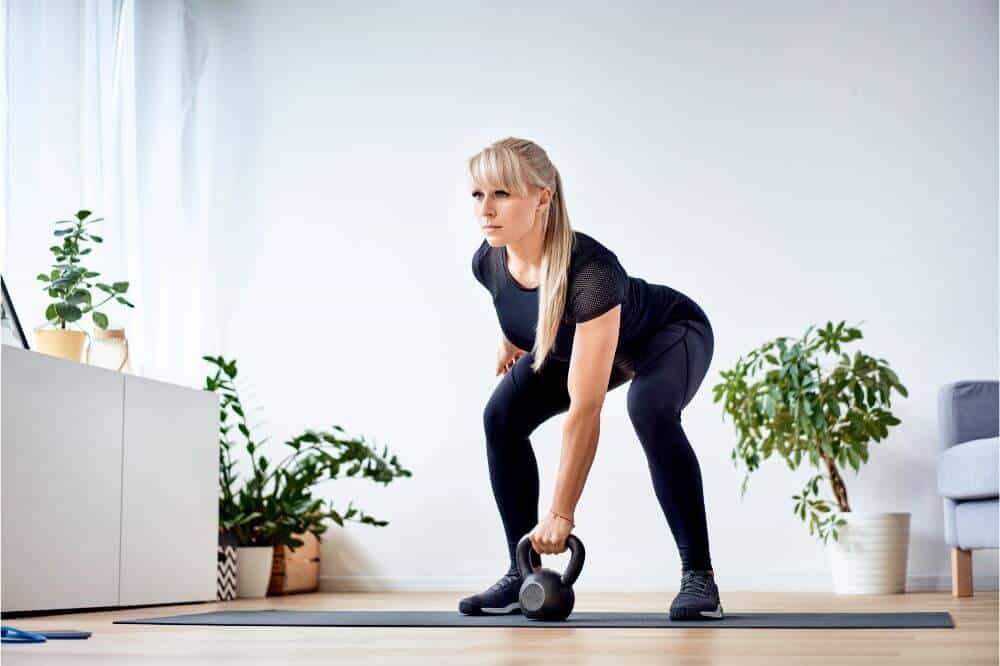Nowadays, kettlebells are seemingly everywhere you look. From exercise classes and gyms to online workout videos, no one can seem to keep their hands off these portable powerhouse weight training tools. But if you have back issues, you might fear that swinging kettlebells around can exacerbate the problems. So, are kettlebells bad for your back? Keep reading to find out.
Are Kettlebells Bad for Your Back?
If you’re looking for a short answer to “Are kettlebells bad for your back?”, it would be, “No, they’re not.” However, while kettlebells aren’t bad for your back per se, there are some guidelines to keep in mind when picking up this handy tool. These guidelines are all the more important if you have a history of back pain or injuries.
Simply put, kettlebells won’t hurt your back if you use them properly. Incorrect use includes the following:
- Using improper technique when exercising
- Overdoing the kettlebell exercises
- Using a kettlebell that’s too heavy
If your kettlebell training goes wrong for any of these reasons, you risk sustaining an injury. Lower back injuries are one of the most common kettlebell injuries and, unfortunately, one of the most severe ones.
However, when done correctly, kettlebell exercises can actually have the opposite effect on your back. They can help strengthen your back muscles, treating back pain in the process. These exercises can help people struggling with non-operative back pain by:
- Improving their posture
- Strengthening their spine.
- Improving their bending form.
- Boosting their confidence in the recovery
Basically, kettlebell training can fundamentally alter the fabric of your back, decreasing the back pain regardless of its cause.
Even if you’ve never experienced back pain, kettlebell exercises can help keep it that way. Since they are perfect for strengthening your core and building back muscles, kettlebell exercises can make you less prone to back injuries and pain.
Again, all these incredible benefits have a huge asterisk next to them with a note stating, “When done correctly!” So, let’s explore what to remember when using kettlebells to avoid injuring your back or worsening your back pain.
What to Avoid When Using Kettlebells
First things first: some people should avoid doing kettlebell exercises, regardless of their form. If you suffer from any conditions affecting your bone density, such as osteoporosis or osteopenia, lifting a heavy unit can increase your risk for fractures. Therefore, it might be best to stay away from kettlebells. The same goes for people at risk of falling.
Apart from health conditions, there are two biggest mistakes people make when deciding to incorporate kettlebells into their workout routine.
The first mistake has to do with this piece of equipment itself. If you choose a kettlebell that’s too heavy, you can risk straining your muscles, including your lower back. However, choosing a kettlebell that’s too light isn’t ideal as well. In those cases, you might not get the right feedback and learn the proper technique, causing you to injure yourself once you switch to a heavier kettlebell.
In general, the right size depends on your weight, height, and strength. As these are highly individual, you can consider starting your training with adjustable kettlebells. After initially using a lighter setting to test your strength, you can work your way up, provided you consult your instructor.
Speaking of the instructor, not getting professional assistance when taking up kettlebell training is the second biggest mistake you can make. Getting the hang of proper form is crucial before doing kettlebell exercises on your own.
A fitness instructor can demonstrate the correct technique and point out your potential mistakes. One of the essential movements to master is the hip hinge. Most beginners tend to flex at the lumbar spine when doing kettlebell exercises, thus putting excessive pressure on its discs. After learning the proper hinging at the hip, your lower back will be protected and pressure-free.
Of course, we are well aware that working with a fitness instructor isn’t accessible to everyone. While you could get the basics of kettlebell training by watching online tutorials, people with back pain or injury shouldn’t risk it. Their safest route is working with a physical therapist or a professional trainer. These experts can advise them on the best kettlebell exercises for the lower back and show you how to do them correctly.

What Kettlebell Exercises Are Good for Your Back?
Having left the “Are kettlebells bad for your back?” questions behind, it’s time to focus on how kettlebell exercises can help your back. Although kettlebell training mostly works the entire body, some exercises are particularly beneficial for your lower back.
Kettlebell Swing
The kettlebell swing is one of the most basic kettlebell exercises. This exercise can be a life-saver when dealing with back pain.
This exercise can be done in a few simple steps:
- Stand upright with your feet a bit wider than hip-width apart.
- Place the kettlebell approximately 12 inches in front of you.
- Extend your arms and grab the kettlebell.
- Swing the kettlebell up to your chest and down through your legs.
Note that this traditional kettlebell swing is known as the Russian swing. There’s also an American version where you swing the kettlebell over your head. This version is not recommended for people suffering from back pain.
There are several things to keep in mind while doing the kettlebell swing to ensure proper technique:
- Keep your shoulders relaxed.
- Thrust from your hips.
- Keep your spine neutral.
- Don’t swing your arms or shoulders.
If you feel any pain while doing this exercise, that’s an indication that something isn’t right. In that case, it’s best to immediately stop and consult your trainer. Also, you should avoid kettlebell swings if you:
- Suffer from herniated discs
- Just had a back surgery
- Can’t bend forward without back pain
Kettlebell Goblet Squat
A kettlebell goblet squat will engage all your lower-body muscles. This exercise is one of the crucial compound moves to include in your workout routine when experiencing back pain. Here’s how you can do this exercise:
- Hold the kettlebell with both hands at your chest, a little further from your chin.
- Squat down as low as it’s comfortable while keeping your kettlebell in the same position.
- Stand back up and repeat the movement.
Remember to keep your back straight and core engaged while going through the motions.
Kettlebell Clean
The kettlebell clean exercise activates most muscle groups in your body, making it an excellent strength-building exercise. Since it’s based on the deadlift movement pattern, the kettlebell clean heavily works your posterior chain, including your lower back. This exercise requires only a few simple steps:
- Stand upright with your feet a bit wider than shoulder-width apart.
- Set the kettlebell about a foot in front of you.
- Pick up the kettlebell with one hand while hinging at the hips.
- Spin the kettlebell to the outside of your wrist, rotating it across your palm at a 45-degree angle. At the same time, stand up with the kettlebell facing outwards.
- Return to the starting position and repeat the movement.
Kettlebells Have Got Your Back
Swinging a kettlebell around might be the last thing to come to mind when looking for a way to alleviate back pain. But this article has explained why the answer to the “Are kettlebells bad for your back?” question is “no.”
On top of that, we’ve shown you how kettlebell exercises can actually be beneficial for diminishing or even preventing back pain. Just don’t forget to consult a physical trainer or a fitness instructor to see if you’re ready to set out on your journey to a pain-free future.

